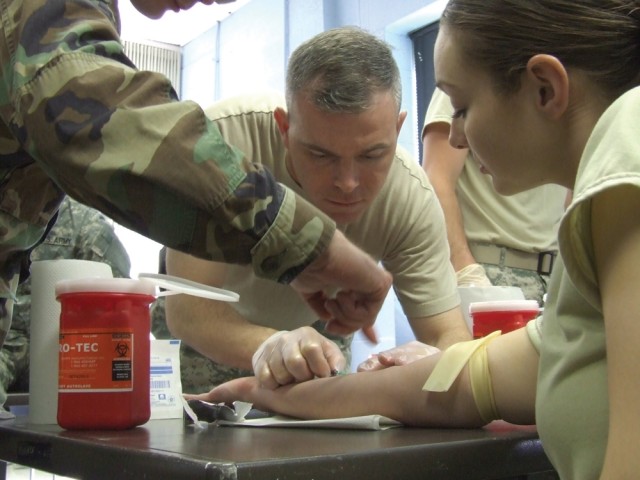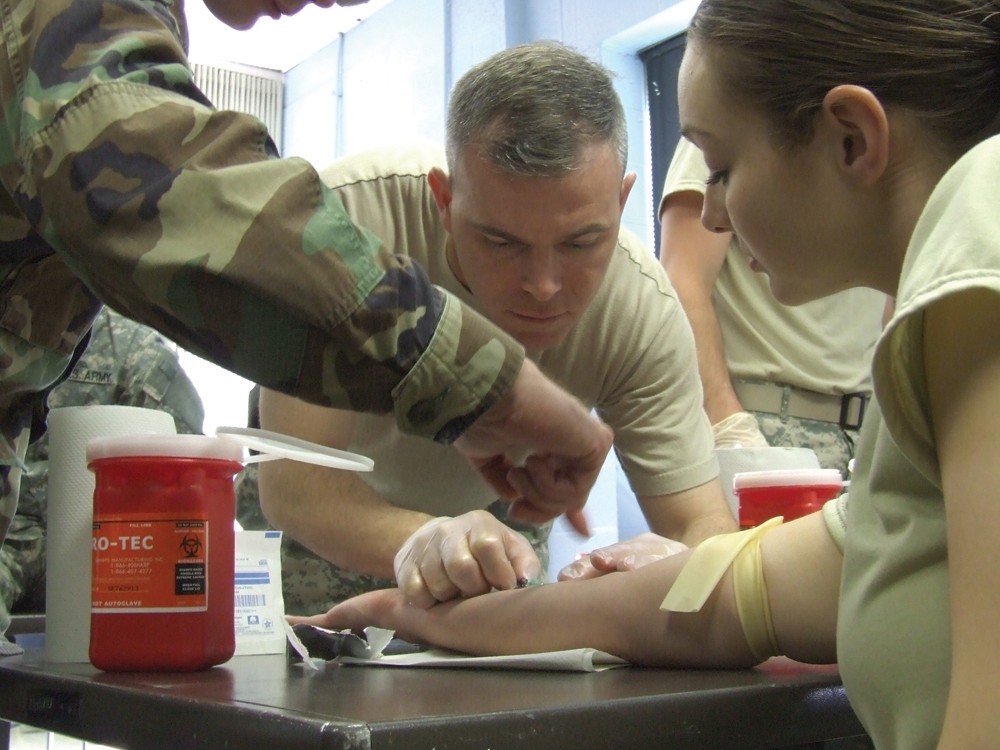TOBYHANNA ARMY DEPOT, Pa. -Army Reservists here learned to administer emergency medical care to frontline warfighters during a three-day battle assembly.
Twenty-eight Bravo Company Soldiers participated in a Combat Lifesaver (CLS) Course acquiring skills to augment the number of combat medics in the field. The course teaches basic medical skills via classroom study and hands-on training.
"Not every Army unit has a medic," said Capt. Shane Abell, Bravo Company commander, 392nd Signal Battalion. "Soldiers are taught to provide the initial care to those wounded in the field until help arrives or the person can be transported."
The combat lifesaver is trained to provide immediate care that can save a casualty's life, such as stopping severe bleeding, administering intravenous fluids to control shock and performing needle chest decompression for a casualty with tension pneumothorax [buildup of air around the lung(s)].
"I had never heard of it before, but now I know how to stick a needle into someone's chest cavity," said Spc. Charles Romito, after learning how to relieve a tension pneumothorax during the course.
To help the Soldiers prepare for the rigors of war, instructors assigned to the 339th Combat Support Hospital, Coraopolis, provided the annual training via a condensed version of the 40-hour course.
"This was the most thorough training, of this kind, that I've ever attended," Romito said. "They covered everything and provided lots of opportunities to learn using hands-on practical applications."
Romito and Staff Sgt. Brian Davis have deployed to Southwest Asia in support of the war on terrorism. After the course, the men expressed confidence in their new lifesaving abilities in the event they were to deploy again.
Davis is the company's information technology manager and Romito is the assistant training sergeant.
"We can't stress enough to our students just how important these classes are," said 1st. Lt. Carl Kusbit, officer in charge of the CLS program. "We mainly instruct those Soldiers who are mobilizing to Iraq, and who have little to no knowledge of lifesaving medical skills."
He admitted that they teach a lot of information in a short period of time, but the Soldiers do well. Once initially certified, Soldiers have a mandatory retest every following year to ensure they've retained the knowledge.
"This was really good training," Davis said. "Training like this helps alleviate fears so you can act."
Students also learned that up to 90 percent of combat deaths occur on the battlefield before the casualties reach a medical treatment facility. Some conditions, such as bleeding from a wound on an arm or leg, tension pneumothorax, and airway problems can be treated on the battlefield.
It has been estimated that the proper use of self-aid, buddy-aid and combat lifesaver skills can reduce battlefield deaths by 15 percent.
"I think everybody got a lot out of the course," Abell said. "We got a chance to see and use some of the newer technology being employed in the field today."
Course graduates carry a small aid bag containing supplies for controlling bleeding, initiating saline lock and intravenous infusion, and other procedures. A saline lock is a catheter inserted into the vein so an IV can be quickly established when necessary.
During the course, Kusbit observed that Bravo Company was one of the more inquisitive and interactive groups he'd seen.
"The skills that we teach Soldiers are very advanced lifesaving skills that can one day save the life of a Soldier in combat," said the lieutenant. "As for the Soldiers we taught at the 392nd, they did very well."
Tobyhanna Army Depot is the Defense Department's largest center for the repair, overhaul and fabrication of a wide variety of electronics systems and components, from tactical field radios to the ground terminals for the defense satellite communications network. Tobyhanna's missions support all branches of the Armed Forces.
About 5,000 personnel are employed at Tobyhanna, which is located in the Pocono Mountains of northeastern Pennsylvania.
Tobyhanna Army Depot is part of the U.S. Army Communications-Electronics Life Cycle Management Command. Headquartered at Fort Monmouth, N.J., the command's mission is to research, develop, acquire, field and sustain communications, command, control, computer, intelligence, electronic warfare and sensors capabilities for the Armed Forces.


Social Sharing